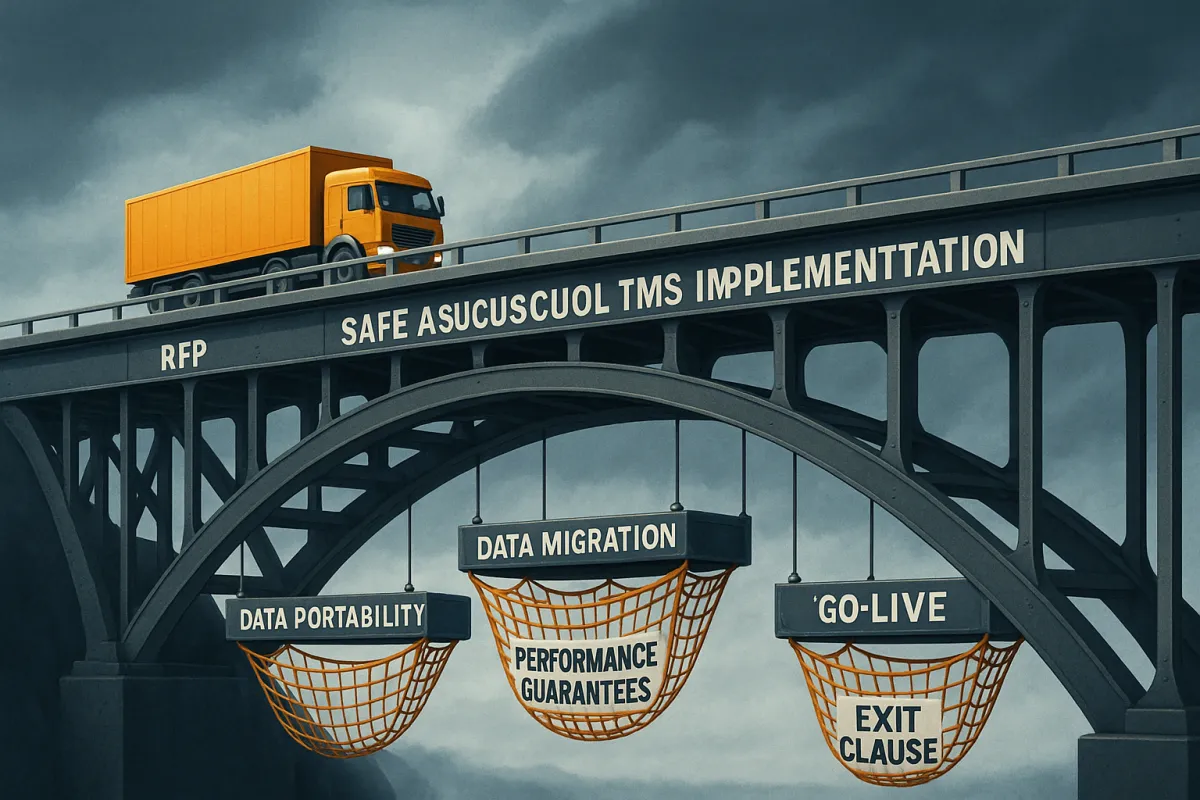TMS Contracts That Protect: 5 Critical Clauses to Prevent Vendor Lock-In and Implementation Failures

Your procurement team just signed off on €300,000 for a transport management software implementation. The go-live is scheduled for Q2, carrier integrations are mapped out, and the business case projects 15% logistics cost savings within 18 months. Then reality hits.
Four months later, you're staring at budget overruns, delayed implementations, and a growing list of change requests. A TMS implementation is an extremely complex undertaking. Manual tendering processes consume far more resources than most companies realize. The root cause? Contract terms that seemed reasonable during procurement but created implementation roadblocks and vendor dependencies that your team never anticipated.
The failure rate tells the story. According to industry research, 66% of technology projects face significant challenges, with transport management software implementations particularly vulnerable to contract-related issues. The good news? Five critical contract clauses can protect European shippers from both vendor lock-in and implementation failures while ensuring long-term flexibility.
Data Portability and Export Rights
Your data strategy starts before you even evaluate vendors. The moment you begin capturing shipment histories, carrier performance metrics, and rate negotiations within a TMS, you're creating valuable business assets. Protecting access to this data requires specific contractual language, not vague promises.
Standards of ownership, i.e. who actually owns the data once it lives on a cloud platform, are not yet developed, which could make it complicated if cloud computing users ever decide to move data off of a cloud vendor's platform. Your contract must specify exact data formats required for export. Demand CSV files, XML structures, and direct API endpoints. Include carrier rate history spanning the full contract period, shipment transaction logs, and performance analytics. Set timeline requirements with teeth - 30 days maximum for standard exports, 60 days for complex data sets with custom formatting.
A UK retailer I worked with learned this lesson the hard way. Their legacy TMS contract included "reasonable data export assistance" but no format specifications or timeline commitments. When they decided to switch providers, the export process took four months and cost an additional €85,000 in consulting fees to convert proprietary formats into usable data.
Modern platforms like Cargoson, MercuryGate, Descartes, and nShift generally provide good data export capabilities, but contract language varies significantly. Insist on export testing during the proof-of-concept phase. Run actual data through the export process and validate that historical trends, rate comparisons, and performance metrics transfer cleanly.
Performance Guarantees and SLA Enforcement
Generic uptime promises don't prevent implementation disasters. You need specific performance commitments with financial consequences for vendors who miss targets. Set uptime requirements at 99.5% minimum with clear penalties for downtime that affects your operations.
Response time commitments matter more during implementation than most procurement teams realize. Demand 4-hour response times for critical issues during go-live phases, 24-hour response for standard support requests. Include implementation timeline penalties tied to milestone-based payments. If your vendor misses the data migration deadline, they should forfeit 10% of that milestone payment.
Integration performance standards prevent the "works in isolation" problem that derails many implementations. A new TMS requires integration with existing software and systems. The complexity of this integration depends on what existing software and systems a company has, its IT support, the costs of such integrations, and how it can approach the integration without disrupting existing business processes. Set specific performance benchmarks for ERP connections, carrier API response times, and data synchronization frequencies.
A German manufacturer recovered €50,000 through SLA penalties when their TMS implementation stretched from 16 weeks to 28 weeks. Their contract included escalating penalties for timeline slippage: 2% of project fees for delays over two weeks, 5% for delays over four weeks, plus vendor-funded project management resources for recovery efforts.
Exit Clause Architecture
Traditional software contracts lock you into annual renewals with 90-day notice periods. TMS contracts require different thinking because switching costs are higher and data migration is complex. Your exit strategy needs to work whether you're changing vendors in 18 months or five years.
Termination rights without cause should include 90-day notice as the industry standard, but with important additions. Require transition assistance that extends beyond data export. The vendor should provide 60 days of parallel system access to validate data accuracy, documentation for carrier integrations, and technical support for the migration process.
Avoid automatic renewal traps entirely. Some contracts may contain clauses that make it difficult or impossible to switch to a different provider. For example, a contract may require the customer to pay a termination fee if it switches providers before the end of the contract term. Instead, structure renewals as explicit decisions with 120 days' notice required from both parties. This forces regular contract reviews and prevents vendor complacency.
Cost structures for early termination should be transparent and declining. A penalty structure that starts at 25% of remaining contract value and decreases by 5% each quarter provides vendor protection while maintaining your flexibility. Include competitor access provisions - you should have the right to engage platforms like Transporeon, Alpega, Oracle TM, and Cargoson for evaluation purposes without contract violations.
Integration and Customization Boundaries
The fastest path to vendor lock-in is accepting proprietary formats and custom development without ownership protections. Your contract needs to establish clear boundaries around what you own versus what remains with the vendor.
Maintain a pre-approved integration list covering your essential systems: ERP, warehouse management, order management, and financial reporting. Include API access rights that survive contract termination. If you've built connections to specific carriers or logistics partners, those integration patterns should remain your intellectual property.
Custom development ownership gets complicated quickly. Any modifications to standard TMS functionality using your business rules, data structures, or process flows should belong to you. The development work itself might be vendor property, but the configurations, parameters, and logic should be portable. Unique data formats: Vendors may gather and store information in unique formats, complicating data transfer to different systems. Existing integrations: Systems are deeply integrated with the current vendor, creating challenges for interoperability with new vendors.
A French 3PL protected their ERP integrations by requiring the vendor to document all connection parameters, authentication methods, and data transformation rules. When they needed to add a new subsidiary's financial system, they could replicate the integration approach independently rather than paying for additional professional services.
Pricing Transparency and Escalation Controls
TMS pricing models have evolved beyond simple per-shipment fees. The MercuryGate platform has some of the best and highest-level functionality, great leadership team, road map for the future and the venture capital to take any company to the next level today and over its lifetime. All this comes at a cost per shipment that starts at roughly $4.00 a shipment and goes down from there, as a company's volumes increases. Your contract needs to address volume commitments, hidden fees, and price escalation with precision that prevents surprises.
Volume commitment flexibility protects you from economic downturns or business model changes. Include renegotiation triggers when your shipping volumes drop more than 20% from contracted levels. This prevents penalty payments during market contractions while giving vendors predictable revenue floors.
Annual price increase caps should tie to EU inflation indices rather than vendor discretion. The European Central Bank's core inflation rate plus 2% provides a reasonable benchmark that reflects actual cost pressures without giving vendors unlimited pricing power. Include competitive benchmarking clauses that trigger repricing discussions when market rates shift significantly.
Hidden fee prohibitions matter more than most procurement teams anticipate. Prohibit charges for standard reporting, routine user training, basic integration support, and normal software updates. Cost transparency requirements should include advance notice for any fee changes and detailed invoicing that itemizes all charges.
Total Cost of Ownership protection requires thinking beyond license fees. Include consulting rates for year two and three in your initial contract. Lock in training costs for additional users. Set maximum charges for routine support activities. Companies evaluating Cargoson, SAP TM, Blue Yonder and other enterprise platforms can use competitive pricing pressure to secure better long-term cost structures.
Negotiation Strategy Framework
Contract terms don't improve through hope. They require systematic leverage and strategic timing. Your negotiation approach should reflect the vendor's position, your implementation timeline, and competitive alternatives.
Leverage multiple vendor quotes throughout the negotiation process. Competitive pressure from FreightPOP, 3Gtms/Pacejet, Uber Freight, and established enterprise solutions forces vendors to justify contract terms rather than relying on standard templates. Share specific contract improvements offered by competitors to create bidding pressure around terms, not just price.
Use industry benchmarks to justify reasonable requests. TMS contract terms have standardized significantly over the past five years. Vendors understand that data portability, reasonable exit clauses, and performance guarantees have become market expectations rather than special requests.
Timeline management affects your negotiating position. Vendors become more flexible as quarter-end approaches and when their sales pipelines need strengthening. Avoid artificial urgency that prevents proper contract review. Allow 45 days minimum for contract finalization including legal review for significant terms.
Engage legal counsel for contracts exceeding €200,000 or when significant customization is required. Procurement expertise handles commercial terms, vendor management, and technical requirements. Legal counsel addresses liability limitations, intellectual property ownership, and regulatory compliance obligations.
Implementation Governance Through Contract Design
Implementation success depends on contract clauses that enforce proper project management, change control, and success measurement. The best technical teams can't overcome poor governance structures embedded in weak contracts.
Change management provisions should include user adoption metrics as delivery criteria. Set specific targets: 80% of active users completing core workflows within 30 days of go-live, 90% of shipments processed through the TMS within 60 days. Include vendor obligations for training reinforcement when adoption rates fall below targets.
Training requirements need specificity beyond "adequate user training." Require role-based training programs, documentation in local languages, and competency validation. Training effectiveness should be measured through user performance rather than attendance records.
Go-live criteria prevent premature launches that create operational chaos. Depending on business size and project scale, implementation of a TMS can take anywhere from a few months to over six months. After selecting the right TMS for specific business needs, implementation often consists of various stages that include a kickoff or initiation meeting, design, build, preparation, testing, deployment, and support from the TMS provider. Define specific performance benchmarks that must be achieved before transitioning from parallel operations: data accuracy validation, integration stress testing, user acceptance sign-off, and fallback procedure verification.
Post-implementation review requirements ensure continuous improvement and contract compliance. Schedule formal reviews at 30, 90, and 180 days post go-live. Include vendor obligations to address performance gaps identified during these reviews. Use review results to validate whether projected cost savings and efficiency improvements are materializing as promised.
Your next TMS contract negotiation represents more than software procurement. It's an opportunity to establish the operational flexibility and vendor relationships that will support your logistics strategy for the next five years. The five critical clauses outlined here - data portability, performance guarantees, exit provisions, integration boundaries, and pricing transparency - provide the foundation for protecting your interests while enabling implementation success.
Start your contract review with data export testing and competitive benchmarking. Document your current vendor dependencies and integration requirements. Most importantly, negotiate from a position of knowledge rather than hope. The complexity of modern TMS implementations demands contract terms that acknowledge this reality and provide practical protections when challenges arise.





